'Pimple' turned out to be shingles

Published on
01 Mar 2022
Published by
The Straits Times
SINGAPORE - Four years ago, Mr Tan Tock Chen had a big and painful bump on his nose, but he thought it was just a pimple.
However, a few days later, rashes started appearing around the spot and spreading across his face, and he felt feverish.
He went to a doctor and was diagnosed with shingles. Later, he also developed blisters very close to his left eye, which might have caused vision loss if he had been untreated.
The 73-year-old retiree, who used to work in human resource management, had to be careful not to rub his eyes as it would cause the blisters to break.
Mr Tan, who had shingles in primary school and did not remember it being painful then, says it was "an uncomfortable and scary experience" this time.
"I suffered from severe pain on my face. It lasted two to three days and kept me up at night. The painkillers were not that effective," says Mr Tan, who is married and has two children aged 44 and 45.
Shingles, which affects one in three people, is a painful blistering rash caused by the same virus that is behind chickenpox.
If a person has had chickenpox, the varicella-zoster virus that caused it may live on in an inactive state in the nerves linked to the spinal cord, even after the spots have cleared. This inactive virus causes shingles, and a temporary weakening in a person's immunity may trigger the virus to become active again.
The most common sign of shingles is a rash, which is usually painful and occurs only on one side of the body.
There are vaccines against shingles, namely GlaxoSmithKline's Shingrix, which contains an inactivated form of the varicella-zoster virus, and
Merck & Co's Zostavax, which contains a live weakened form of the virus.
Moderna and Pfizer-BioNTech are developing shingles vaccines based on messenger RNA technology. Clinical trials for the shingles vaccine Pfizer and BioNTech are developing together are expected in the second half of this year.
Dr Zeng Shanyong, a resident doctor at DTAP Clinic in Holland Village, says the rash usually begins on a patch of skin served by a single nerve. Within a few days, blisters and ulcers might form, which eventually dry and crust over seven to 10 days. Scarring and pigmentation might come about even after the rash resolves.
The most common symptom of shingles is pain caused by acute nerve inflammation, says Dr Zeng.
"Most patients describe it as 'burning' and 'stabbing' in nature, and the pain level can be as severe as the pain of childbirth," he adds.
The rash can also spread over a wide area. This is known as disseminated zoster and can happen in patients with a suppressed immune system, such as those receiving chemotherapy or patients with the human immunodeficiency virus.
In severe cases, it may cause an infection in the lungs, and inflammation of the liver and brain tissue.
Besides rashes, symptoms of shingles include sensitivity to light, headache, fatigue and fever.
The infection can also affect the cornea.
Dr Asok Kurup, an infectious disease specialist at Mount Elizabeth Medical Centre, explains that blister-like eruptions due to shingles that appear like pimples on the side or tip of the nose are associated with infection in the eye, because the same nerve supplies this part of the nose and the eye.
This is called keratitis, and it can occur as a complication if a person has a rash that typically involves one side of the upper face, forehead and scalp.
The condition can lead to numbness of the cornea, scarring and infection, which can cause blindness.
While shingles is generally not life-threatening, it can cause pain over a prolonged period of time.
Patients can develop post- herpetic neuralgia, where they experience pain in the affected area for weeks and months even after the blisters dry up and disappear.
Doctors say this complication can affect 10 to 30 per cent of patients with the condition, with the risk increasing with age.
Dr Kurup once saw a 65-year-old businessman with diabetes, hypertension and heart disease who had a rash and developed severe pain over the left side of his forehead.
The patient, who consulted Dr Kurup five days after the onset of shingles, had a rash complicated by a bacterial superinfection.
"He needed antibiotics and antiviral therapy. He also had to stay in the hospital due to the severity of the infection. His condition eventually improved, but he suffered complications of pain for several weeks," Dr Kurup adds.
As shingles can be transmitted through the air or through touching the rash, exposure to patients with shingles should be reduced or avoided.
Dr Kurup advises patients to keep the rash covered if possible, and to wash their hands often to prevent the spread of the virus to others.
Dr Zeng notes that once the rash is dry and crusting, patients are considered non-infectious.
In Mr Tan's case, he was discharged from hospital after four days, when his fever subsided and he was deemed non-infectious.
Doctors usually prescribe antiviral medications and strong painkillers to lessen the pain and quicken healing. It may take up to five weeks for patients to recover and the rash to fully clear.
Adults above age 50 are encouraged to be vaccinated against shingles, as they are at a higher risk of getting it due to the decline of an important part of the immune system called cellular immunity, notes Dr Kurup.
Doctors urge people to seek medical help as soon as possible if they suspect they have the disease.
Says Dr Kurup: "Prevention is always better, hence getting vaccinated is the best strategy."
Mr Tan, who was not aware there was a vaccination against the disease and hence was not inoculated, says: "I thought I had immunity against the disease because I had chickenpox and shingles when I was young. After this incident, I realised the importance of vaccination."
About the infection
Shingles, which affects one in three people, is a painful blistering rash caused by the same virus that is behind chickenpox.
Symptoms
• Pain
• Sensitivity to light
• Itching
• Headache
• Fatigue
• Fever
Possible complications
• Keratitis, which can lead to numbness of the cornea, scarring and infection, which can cause blindness.
• Post-herpetic neuralgia, where patients experience pain in the affected area for weeks and months even after the blisters dry up and disappear.
• Bacterial skin infections, as a result of shingles lesions that take a long time to heal.
Get vaccinated
• GlaxoSmithKline's Shingrix contains an inactivated form of the varicella-zoster virus.
• Merck & Co's Zostavax contains a live weakened form of the virus.
Source: The Straits Times © Singapore Press Holdings Limited. Reproduced with permission.
ALL views, content, information and/or materials expressed / presented by any third party apart from Council For Third Age, belong strictly to such third party. Any such third party views, content, information and/or materials provided herein are for convenience and/or general information purposes only. Council For Third Age shall not be responsible nor liable for any injury, loss or damage whatsoever arising directly or indirectly howsoever in connection with or as a result of any person accessing or acting on any such views, content, information and/or materials. Such third party views, content, information and/or materials do not imply and shall not be construed as a representation, warranty, endorsement and/or verification by Council For Third Age in respect of such views, content, information and/or materials.







